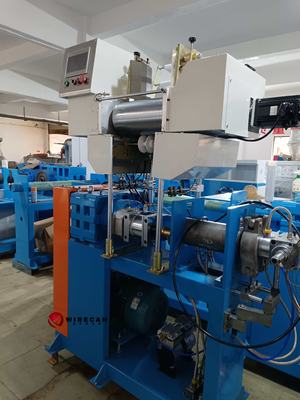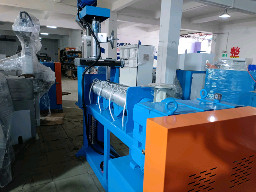Automatic Operation Automatic Feeding Equipment/ Wire Cable Machine
Product Details:
| Place of Origin: | CHINA |
| Brand Name: | WIRECAN |
| Certification: | ISO9001 |
| Model Number: | WRK-767 |
Payment & Shipping Terms:
| Minimum Order Quantity: | 1 set |
|---|---|
| Price: | USD 30000-50000 |
| Packaging Details: | Wooden Case |
| Delivery Time: | 30 DAYS |
| Payment Terms: | T/T |
| Supply Ability: | 25 Sets/Month |
|
Detail Information |
|||
| Cable Core: | Single-Core | Cable Diameter: | 0.9-2.0mm |
|---|---|---|---|
| Cable Length: | 10-200m | Cable Strength: | >1000N |
| Crimping Accuracy: | ±0.2mm | Crimping Force: | >1000N |
| Fiber Count: | 1-12 | Fiber Diameter: | 0.25-0.9mm |
| Fiber Length: | 10-200m | Fiber Type: | G652D, G657A1, G657A2 |
| Material: | Aluminum Alloy | Product Name: | Fiber Optic Cable Machine |
| Speed: | 200-500pcs/h | Tensile Strength: | >1000N |
| Type: | Automatic | ||
Product Description
Automatic Feeding Equipment
Description:
Automatic feeding equipment is a system designed to automate the feeding process in various industrial applications. It is commonly used in manufacturing and production lines to efficiently and accurately feed materials or components into machines or assembly processes.
Features:
1. Precision and Accuracy: Automatic feeding equipment is equipped with sensors, actuators, and control systems to ensure precise and accurate feeding of materials. This helps in maintaining consistent product quality and reduces errors.
2. Customizable Configurations: The equipment can be customized to accommodate different sizes, shapes, and types of materials. It can handle a wide range of materials, including granules, powders, liquids, and parts of various dimensions.
3. Automated Operation: The system operates autonomously, reducing the need for manual intervention and minimizing labor requirements. It can be integrated with other machinery or production lines, enhancing overall efficiency and productivity.
4. Flexibility and Adaptability: Automatic feeding equipment can be programmed to adjust feeding rates, timings, and quantities based on specific production requirements. It offers flexibility to adapt to varying production demands and enables quick changeovers between different materials or components.
5. Safety Measures: The equipment is designed with safety features to prevent accidents and ensure operator well-being. It may include emergency stop buttons, safety guards, and sensors to detect and respond to potential hazards.
6. Monitoring and Control: Advanced systems include monitoring and control interfaces that allow operators to monitor the feeding process, adjust settings, and troubleshoot issues. Real-time data and feedback enable better process optimization and performance analysis.
Benefits:
1. Increased Efficiency: Automatic feeding eliminates the need for manual feeding, reducing human error and improving overall production efficiency. It ensures a continuous supply of materials, minimizing downtime and enhancing productivity.
2. Cost Savings: By optimizing material usage, reducing waste, and streamlining production processes, automatic feeding equipment can result in cost savings over time. It eliminates the need for manual labor, reducing labor costs and improving operational efficiency.
3. Enhanced Product Quality: Precise and consistent feeding ensures uniformity in product quality. This leads to improved customer satisfaction and reduces the risk of defective products.
4. Time Savings: Automated feeding reduces the time required for material handling and loading, allowing operators to focus on other critical tasks. This results in time savings and increased production output.
5. Safety and Ergonomics: Automatic feeding equipment promotes a safer working environment by minimizing the need for manual handling and reducing physical strain on operators. It mitigates the risk of injuries and improves workplace ergonomics.
Automatic feeding equipment offers numerous advantages in terms of efficiency, cost savings, quality control, and operator safety. It is a valuable solution for industries that require consistent and reliable feeding of materials in their manufacturing processes.
![]()
| Feature | Description |
|---|---|
| Automation | Fully automated system for feeding cables into production processes |
| Precision | Ensures accurate and consistent feeding of cables |
| Compatibility | Suitable for various cable types and sizes |
| Speed | High-speed feeding capability, optimizing production efficiency |
| Customizability | Configurable to accommodate different cable diameters and lengths |
| Safety | Equipped with safety sensors and emergency stop mechanisms for operator safety |
| Integration | Can be seamlessly integrated with other machinery or production lines |
| Control System | Advanced control interface for monitoring and adjusting feeding parameters |
| Material Handling | Efficiently handles cable reels or spools for smooth feeding |
| Error Detection | Includes sensors and alarms to detect feeding errors or jams |
![]()
![]()
![]()











